
Right?
Well, yes, no, maybe... let me explain.
Let's think logically for a moment... What is the densest part of an animal?
If you answered, "The bones" you are correct - (congratulations, here's a sticker).
Bones are very dense, they hold the animal upright, don't deteriorate quickly and have been there since the beginning of its life.
So, if the animal has a history of mistreatment, stress, drugs, poor feed, bioaccumulation of chemicals (these are all factory farming side effects by the way) then, where, pray tell do those thing accumulate?
Right, again - in the bones.
So don't eat them.
Here is where I digress to being a lunatic Rancher again.
You know, the lunatic who says to the Vegan passing by my Grass-Fed and Finished Booth at the Farmer's Market: "Why don't you eat meat?"
"Because I don't agree with the way Animals are treated in our Modern Farming Systems", they reply.
"I wholeheartedly agree, if we didn't raise our own animals the right way, I would encourage everyone to be like you"
At this point, they are stunned. Blinking their eyes with astonishment they can't believe a Rancher wearing a cowboy hat would advocate the the world go vegan. Not sure whether to hug me or run away scared, they stammer the only word that comes to mind..."Huh?"
I take that as an invitation to excitedly explain how farming can be done with integrity, truth and dignity towards the animals and environment entrusted to our care. How this can heal our hurting earth, and how these methods produce an exceptional tasting, nutrient dense product far superior to any vegetable available, all-the-while sequestering 10x the carbon we produce.
So, why would I campaign against something as food righteous as bone broth?
Because well meaning folks read a nutrition website heralding the benefits of Bone Broth then run off to their local industrial grocery store, find the poorest quality, "organic" factory chicken or beef with no thought for how it was raised, kept, fed or cared for and make an easily digestible direct injection of bone broth, laden with chemicals and antibiotics directly into their digestive system, all the while proclaiming "health".
Are you kidding me?
I am now in that awkward position of having to tell people the truth - and boy-oh-boy is that unpopular in this current climate!
So, here we go...
Just like the poorly informed but well intentioned Vegan, "Bone Broth-ers" are lost in the clutter of commercialism. Doomed to poison themselves if not tossed a life line of common sense. They drink gallons of industrial "organic" Broth simply because it has a fancy label confident that it will heal their every ailment.
Lord help us!
When you drink broth, made from a factory-tortured animal you are consuming the greatest nutritional density you can find of that animals mistreatment, poor health and shoddy feed regime. If you don't start with the best possible elements, from the beginning, you are hamstringing your efforts from the get go. With nutritionally dense products, like bone broth, you must start at the apex of quality before distillation and rendering (same goes for making lard and tallow from fats by the way).
"Well," you say, "My beef bone broth is "Grass-fed"." So it is just fine, right? Wrong. Read this article to find out what "Grass-fed" really means.
In this and the following blogs (parts 2 and 3 will follow) I am going to detail how you, at home, can make the very best bone broth in large quantities with very little money and effort. You can have significantly greater quality, for a fraction of the price you will find in any store. It will take effort, but no, you will not collapse from exhaustion. We've done this for years in our home and get better each time we process a batch. It can be done on a Saturday with a leisurely amount of exertion. Watch the football game, or visit with the family and process a batch of broth to keep your system well fed and going for 6 months.
Efficiency comes with practice. Practice requires patience. Your health is worth it. Trust me.
Ok, let's begin...
First you need good equipment. Notice I said "good" not expensive. I believe in frugality. Experts tell us that our Grandparents lived in the generation of resource extraction, and we live in the generation of resource recycling. It is astonishing what is being thrown away by our generation.
One aspect I love about bone broth is reuse - it tickles the little environmentalist deep inside my Rancher heart. You get to re-use the jars, process an exceptional product, from a somewhat unwanted byproduct (bones) on your own, with used equipment, and all for the price of pennies.
It's a win-win.
Your task is to find the following:
1. Used canning jars. All shapes and sizes. Look on Craigslist. If Craigslist-ers give you the heebie-jeebies then use Facebook Marketplace. You can view the profile of the person you are buying from with Facebook Marketplace, so at least you can see who the person is and judge whether they are reputable or not. My wife feels a little better about her transactions on Facebook Marketplace rather than Craigslist because of this. Anyway, use one of the apps/websites that has used stuff for sale. It's a great way to conserve resources and keep things out of landfills. Plus, you're buying canning jars - axe murders usually don't have canning equipment for sale, so you are probably safe anyway.
2. A pressure canner. I found one on the side of the road one time. Really, like as if someone was waiting for the trash guys to pick it up. This stuff is so unused, in today's society, that I've found them for $3 at a garage sale (they sell new for $200). They look like this... make sure it has a pressure gauge.
Or buy one from an elderly lady who loves to garden and "put up" the extra larder for winter. Go over to her house, have a great talk with her and make her day - it will make yours too (trust me I know from experience). She has probably forgotten more about canning than I will ever know. She will most likely enjoy giving you all her canning secrets.
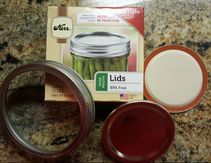
4. Rings - for the size jars you have.
5. Jar lifter. This handy little invention makes lifting a very hot jar from your pressure cooker/canner a breeze. Your jars can get to 250 degrees inside the canner. After the canner depressurizes, you will need to lift the jars out (more on that later), so you will need this lifter.
6. Pastured, non-GMO fed, non-Soy fed chicken bones. If you've raised them and fed them on your own - good, use those. You will be the sole guarantee that they are fed and pastured correctly. If you don't or can't raise chickens because you live in a nanny-state that tells you what you can and cannot do with you land, then try to find a highly reputable source for bones. Ask to see the feed bag labels. Feed bag labels are very common. You don't have to be a genius to read them either - they read like food ingredients. You can read a label and know exactly what ingredient the chicken is eating. Look for the word "organic" before each ingredient. This will guarantee non-GMO. A feed bag label should be as common as a shovel on a pasture based ranch. If a farmer cannot furnish a feed bag label he or she is a fraud and is most likely buying commodity chicken and passing it off as their own.
Do not settle for "Organic" chicken bones from a grocery store. "Organic" when it comes to fruits and veggies means everything. When it comes to animals it means almost nothing. The health of an animal stems from its environment and interaction with its environment. Animals can survive on almost anything, but coop them up, remove natural light, dirt, the ability to move around (a lot) and normal animal function and their health (plus the health of anything consuming that animal - like you) will plummet. We say 80% of animal welfare is environmental. The remaining 20% is what they are fed.
To learn more about what a chicken should eat click here.
We take the breasts, wings and legs off the chicken. We use the backs as pictured here for broth. This does two things; first, you get a ton of meat and fat with your bones. The fat is drenched with Omega-3's (the same reason we eat salmon). These fats are perfectly suited for assimilation by your body as you digest the broth. Your gut lining can easily recognize this and digest it quickly for healing.
Secondly, this portion of the animal is often wasted. You are conserving resources when you use chicken backs. They really have no other purpose than broth - so be a green warrior and use the chicken backs.
In part three, we will pressure can our Broth to USDA standards. This allows a large portion to be made at once, keeping cost and effort to a minimum and allow us to safely store our Broth as a shelf-stable item without using any energy to operate a freezer or refrigerator.
Stay tuned, we are going to save money, save resources and heal our guts all at once...
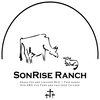

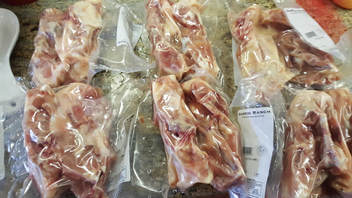
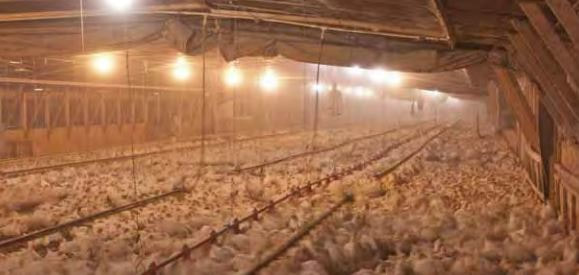

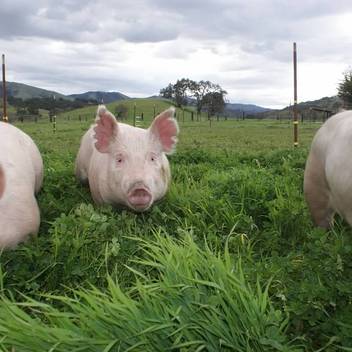

 RSS Feed
RSS Feed